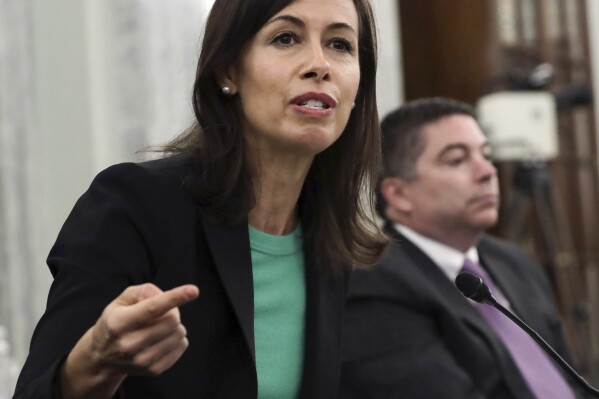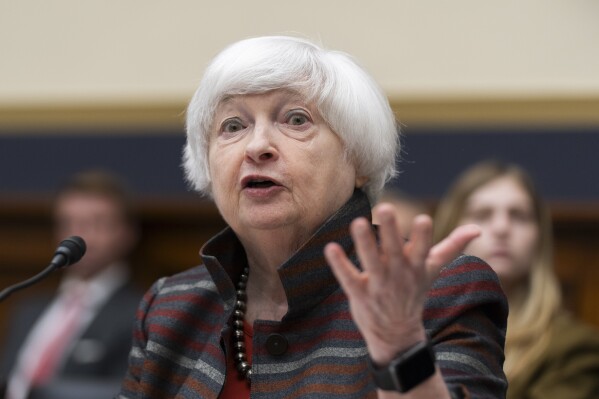Inflation is nearly back to 2%. So why isn’t the Federal Reserve ready to cut rates?
WASHINGTON (AP) — From Wall Street traders to car dealers to home buyers, Americans are eager for the Federal Reserve to start cutting interest rates and lightening the heavy burden on borrowers.
The Fed is widely expected to do so this year — probably several times. Inflation, as measured by its preferred gauge, rose in the second half of 2023 at an annual rate of about 2% — the Fed’s target level. Yet this week, several central bank officials underscored that they weren’t ready to pull the trigger just yet.
Why, with inflation nearly conquered and interest rates at a 22-year high, isn’t now the time to cut?
Most of the Fed’s policymakers have said they’re optimistic that even as the economy and the job market keep growing, inflation pressures will continue to cool. But they also caution that the economy appears so strong that there’s a real risk that price increases could re-accelerate.



Several officials have said they want more time to see if inflation continues to subside. In the meantime, they note, the economy is solid enough that it can thrive without any rate cuts.
“They’re going to be glacial, and take their time,” said Steven Blitz, chief US economist at GlobalData TS Lombard. “They’re willing to say, ‘We don’t know, but we can afford to wait so we’re going to wait.’ ”
The sturdiness of the economy has also raised questions about just how effective the Fed’s 11 rate hikes have been. If much higher borrowing rates are only barely restraining the economy, some officials may conclude that high rates should stay in place longer or that very few rate cuts will be needed.
In the meantime, the economy’s continued resilience gives them the luxury to take a cautious approach. Last month, for example, America’s employers delivered a burst of hiring to begin 2024, adding 353,000 jobs in January. And the unemployment rate stayed at 3.7%, just above a half-century low.
“I don’t feel there’s a sense of urgency here,” Loretta Mester, president of Federal Reserve Bank of Cleveland, told reporters Tuesday. Mester is among 12 Fed officials who vote on interest rate policy this year. “I think later this year, if things evolve as anticipated, we would be able to start moving the rate down.”
Yet their caution carries risks. Right now, the economy appears on track for a “soft landing,” in which inflation would be defeated without causing a recession or high unemployment. But the longer that borrowing rates stay high, the higher the risk that many companies and consumers would stop borrowing and spending, weakening the economy and potentially sending it into a recession.
High rates could also compound the struggles of banks that are saddled with bad commercial real estate loans, which would be harder to refinance at higher rates.
The high cost of borrowing has become a headache for David Kelleher’s Chrysler-Jeep dealership just outside of Philadelphia. Just 2 1/2 years ago, Kelleher recalled, his customers could get an auto loan below 3%. Now, they’re lucky to get 5.5%.
Customers who had monthly car lease payments of $399 three years ago are finding that with vehicle prices much higher now and interest rates up, their monthly payments on a new car would be closer to $650. The trend is pushing many of his customers toward lower-priced used cars — or no purchase at all.
“We need the government to address the interest rates ... and understand that they’ve accomplished their goal of lowering inflation,” Kelleher said. “If interest rates can come down, I think we’re going to start selling more cars.”
Kelleher is likely to get his wish by May or June, when most economists expect the Fed to start reducing its benchmark rate, which is now at about 5.4%. In December, all but two of the 19 policymakers that participate in the Fed’s policy discussions said they expect the central bank to cut rates this year. (Twelve of those 19 actually get to vote on rate policies each year.)
Yet economic growth, by some measures, has accelerated since then. In the final three months of last year, the economy expanded at an unexpectedly strong 3.3% annual rate. Surveys of manufacturers and service-providers, such as retailers, banks, and shippers, also reported that business perked up last month.
Collectively, the latest reports suggest that the economy may not be headed for a soft landing but rather what some economists call a “no landing.” By that they mean a scenario in which the economy would remain robust and inflation an ongoing threat, potentially stuck above the Fed’s target. Under this scenario, the Fed would feel compelled to keep rates at elevated levels for an extended period.
Powell said last week that while the Fed wants to see continued “strong growth,” a strong economy does threaten to send inflation up.
“I think that is a risk ... that inflation would accelerate,” Powell said. “I think the greater risk is that it would stabilize at a level meaningfully above 2%. ... That’s why we keep our options open here and why we’re not rushing.”
Other officials this week drove home the point that the Fed is trying to balance the risk of cutting rates too soon — which might cause inflation to re-accelerate — and keeping rates too high for too long, which could trigger a recession.
“At some point, the continued cooling of inflation and labor markets may make it appropriate to reduce” rates, Andrea Kugler, a recently appointed Fed governor said Wednesday in her first public speech. “On the other hand, if progress on disinflation stalls, it may be appropriate to hold the target range steady at its current level for longer.”
Some analysts have pointed to signs that the economy is becoming more productive, or efficient, allowing it grow faster without necessarily increasing inflation. Yet productivity data is notoriously hard to measure, and any meaningful improvement wouldn’t necessarily become apparent for years.
Still, “maybe the economy can take higher interest rates than we thought in 2019 before the pandemic,” said Eric Swanson, an economist at the University of California, Irvine.
If so, that might not just delay the Fed’s rate cuts, but result in fewer of them. Fed officials are still saying they plan to cut rates perhaps three times this year, below the five or six that some market analysts foresee.
Disclaimer: The copyright of this article belongs to the original author. Reposting this article is solely for the purpose of information dissemination and does not constitute any investment advice. If there is any infringement, please contact us immediately. We will make corrections or deletions as necessary. Thank you.






